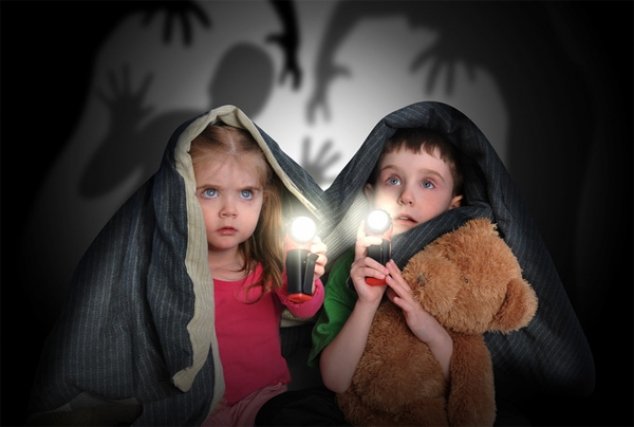DADDY DO NOT TURN OFF THE LIGHT PLEASE - Fear of darkness in childhood
Fear of darkness in childhood
The fear of the dark is characteristic of childhood. It usually starts around the age of two, when the child begins to develop a great imagination, continues to be frequent in later ages and begins to decline around nine years. The fear of the dark is associated with different fears, such as separations, loneliness, beings Imaginaries, etc., and is one of the causes of sleep problems. When they are in bed and in the dark, some children will hear at night noises because the parents are at home and have not left, while others are startled to interpret that some brick or fictional character has forced the door Y Is stealthily approaching. Most children overcome their fear of the dark with the passage of time. In some cases fear persists for many years, it can cause discomfort and negatively affect child functioning.
How to overcome the fear of darkness through play.

The game is a pleasant and therapeutic activity, can also be used to overcome the fears. In the case of fear of the dark, you can use the game of "hidden", through it we can play with the child hiding, serving as "models" and making them also hide and stay for a few seconds in places Dark rooms, closets or some other hiding place. In this way the child will learn by successive approximations to remain a few seconds alone and in the dark, later will increase the levels of time, without forcing it, because it should be a moment of learning, joy and pleasure. Fear of darkness is commonplace in childhood, but children should be taught to overcome it gradually.
Sleep problems: Nightmares and night terrors
Night terrors are sudden awakenings, which begin with cries or tears of anguish and are accompanied by signs of intense fear. The child sits on the bed with a terrified facial expression. He does not react to his parents' efforts to reassure him. If they finally do, they are confused and disoriented for a few minutes. Night terrors are much less frequent than nightmares. They can occur between four and twelve years and tend to disappear on their own in adolescence.
Nightmares are long terrifying dreams whose contents revolve around threats to their own survival or safety, for example, that a tiger chases and attacks the child or that he falls into the void, then wakes up frightened and vividly remembers the story of the dream . Nightmares are common in childhood and usually appear between three and six years of age. They are related to feelings of insecurity, anxieties, fears and worries, they also tend to be related to new experiences for the child that have happened to him during the day and that are difficult or fearful to him. For example rivalries with schoolmates or siblings, insecurity, painful or traumatic events, aggressive reactions, all cause stress to the child. They can also be easily induced by illness, pain and overexcitement of violent television programs or by extreme threats from parents.
We must take into account that young children do not know what is a dream and reality, so they are scared more than when they grow up and they realize that it has been a dream.
The most appropriate parenting action is to reassure, try to distract him, and then during the day hold a conversation with him about the nightmare and help him to deal with his problems and feel safe.
Recommendations for Parents
* Reassure the child and give him security: Tell him that everything is okay for him to feel safe, without exaggerating or giving much importance to the nightmare, since it can create greater dependence on the child and be used to attract attention.
* Avoid excessive excitement: Before bedtime, children should have a period of relaxation. It should be avoided therefore violent physical activities, regular programs or horror films often stimulate the imagination of children, especially if they go to sleep in a dark room. Parents should eliminate or limit the number of such programs, especially near bedtime.
* Do not accept that the child sleeps with the parents: If the child wakes up for some nightmare, it should be reassured, given security, which does not mean sleeping with them, this can give the child the impression that in reality if there is something to What to fear
* During the day you can talk to the child, know their dreams to have information about their fears and concerns and talk with him about it.
* Set the sleep schedule: Make sure your child has a regular sleep schedule and that they get enough rest.
* Teach your child to fight their fear: If your child is afraid of the dark, tell him to imagine something nice and relaxing (a game, a walk), these are simple techniques that will help the child learn to control their fears.
* Consolidate a bedtime routine that provides safety to the child. Sleep problems are often the product of bad habits and the lack of a routine that allows gradual adjustment of sleep.

Recommended Routine Before Bedtime:
1. About 15 minutes before, tell your child that bedtime is approaching. This is to prepare the child
2. Perform quiet play, you can allow the child to see drawings on television.
3. Bathe and put your pajamas on.
4. Acuéstelo and sing or tell a story, is that these moments before sleep are quiet, relaxing. You can also talk with him about something nice that happened to the child during the day.
5. Say goodbye to the child, give him a kiss, good night, turn off the light and leave the room.
SOURCE: http://www.cosasdelainfancia.com

PD: Sorry for my english :$